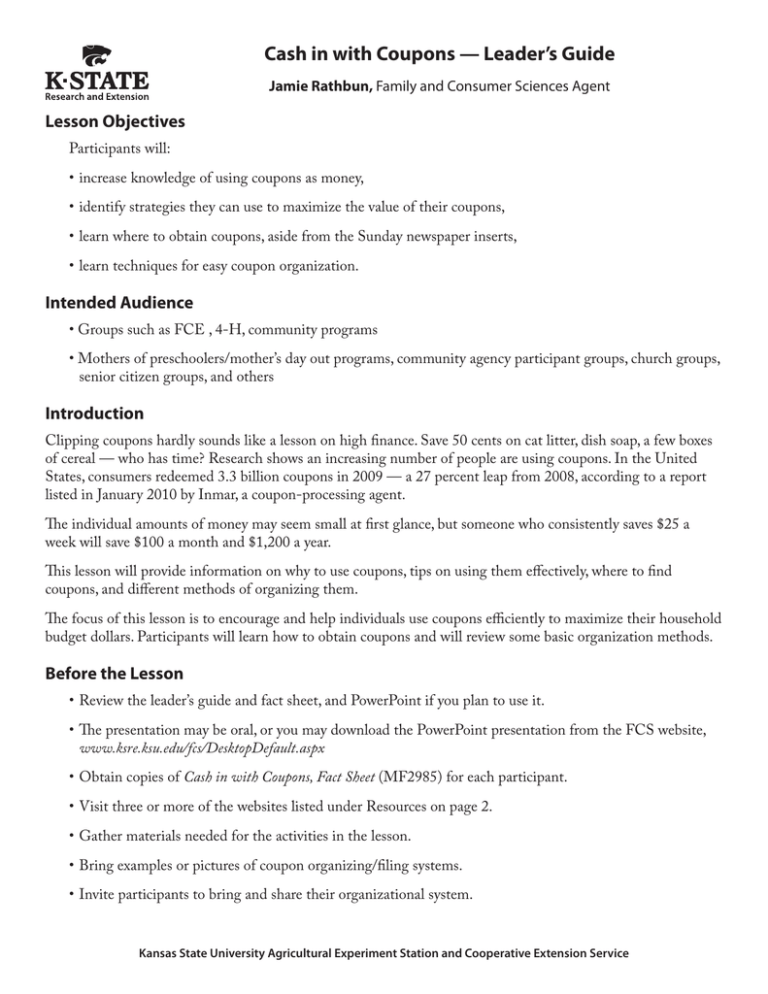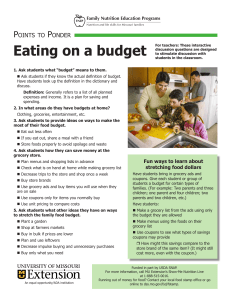
Cash in with Coupons — Leader’s Guide
Jamie Rathbun, Family and Consumer Sciences Agent
Lesson Objectives
Participants will:
•increase knowledge of using coupons as money,
•identify strategies they can use to maximize the value of their coupons,
•learn where to obtain coupons, aside from the Sunday newspaper inserts,
•learn techniques for easy coupon organization.
Intended Audience
• Groups such as FCE , 4-H, community programs
• Mothers of preschoolers/mother’s day out programs, community agency participant groups, church groups,
senior citizen groups, and others
Introduction
Clipping coupons hardly sounds like a lesson on high finance. Save 50 cents on cat litter, dish soap, a few boxes
of cereal — who has time? Research shows an increasing number of people are using coupons. In the United
States, consumers redeemed 3.3 billion coupons in 2009 — a 27 percent leap from 2008, according to a report
listed in January 2010 by Inmar, a coupon-processing agent.
The individual amounts of money may seem small at first glance, but someone who consistently saves $25 a
week will save $100 a month and $1,200 a year.
This lesson will provide information on why to use coupons, tips on using them effectively, where to find
coupons, and different methods of organizing them.
The focus of this lesson is to encourage and help individuals use coupons efficiently to maximize their household
budget dollars. Participants will learn how to obtain coupons and will review some basic organization methods.
Before the Lesson
•Review the leader’s guide and fact sheet, and PowerPoint if you plan to use it.
­•The presentation may be oral, or you may download the PowerPoint presentation from the FCS website,
www.ksre.ksu.edu/fcs/DesktopDefault.aspx
•Obtain copies of Cash in with Coupons, Fact Sheet (MF2985) for each participant.
•Visit three or more of the websites listed under Resources on page 2.
•Gather materials needed for the activities in the lesson.
­•Bring examples or pictures of coupon organizing/filing systems.
­•Invite participants to bring and share their organizational system.
Kansas State University Agricultural Experiment Station and Cooperative Extension Service
Presenting the Lesson
Begin with an icebreaker. Ask “How many people use coupons? How often? Where do you find your coupons?”
Community Awareness Activities
•Present the lesson to another group that could benefit from this information.
•Send the link for the fact sheet in an e-mail to family and friends.
•Coordinate a coupon exchange in your community (with mothers at play group, even a box at the local
library with a “you put some in, you can take some out” policy).
•Collect and use coupons to buy products to donate to food banks or holiday food baskets.
•Send expired coupons to the military. Coupons for Troops started in 2008 with the goal of providing
expired and non-expired coupons to military families stationed overseas. The prices in overseas
commissaries are significantly higher than those in the States and military families do not always have
access to coupons in newspapers and inserts. Military commissaries overseas accept coupons up to six
months past the expiration date. Military commissaries accept manufacturer coupons as well as Internetprinted coupons. The commissary is a grocery store, so only “grocery” coupons are needed. Families cannot
use store-specific coupons (i.e. Target, Walgreens, Kroger). Visit http://thehappyhousewife.com/donateexpired-coupons-to-military-families-overseas/ to learn more or sign up.
Resources
eXtension Personal Finance Articles
“Stretching Your Food Dollar,” www.extension.org/pages/Stretching_Your_Food_Dollar
“Practical Ways to Trim High Grocery Prices,”
www.extension.org/pages/Practical_Ways_to_Trim_High_Grocery_Prices
“Coupons abound though use is low,” www.extension.org/pages/Coupons_Abound_Though_Use_is_Low
Spend Smart, Eat Smart program, Iowa State University Extension, www.extension.iastate.edu/foodsavings
The Simple Dollar, www.thesimpledollar.com
Money Saving Mom, www.moneysavingmom.com
Couponing 101, www.couponing101.com
Reviewers
Deb Wood, Family and Consumer Sciences Agent, K-State Research and Extension – Geary County
Carol Young, Family Financial Management Specialist, K-State Research and Extension
Evaluation for Cash in With Coupons
Date:
Your County/District:
Are You: Male Female
Age Category:
20-40 41-65 65 and over
1. How important to you is the information you received today?
Not at all
Somewhat
Very
2. As a result of this program, I learned more about using coupons.
No
Yes, a little
Yes, some
Yes, a lot
3. How often do you think you will use the information provided in this program?
Never Once a month
Once a week Daily
4.After today, how likely are you to practice one of the suggestions for maximizing the value of your
coupons?
Not at all
Somewhat
Very
5. Please specify what you learned that you did not know or that surprised you.
6. Which coupon practice will you start using?
Please write any additional comments here:
Return completed survey information to the author:
Jamie Rathbun, Family and Consumer Sciences Agent
K-State Research and Extension – Ellsworth County
210 N Kansas, Suite 1
Ellsworth KS 67439
785-472-4442
jrathbun@ksu.edu
Brand names appearing in this publication are for product identification purposes only.
No endorsement is intended, nor is criticism implied of similar products not mentioned.
Publications from Kansas State University are available at: www.ksre.ksu.edu
Publications are reviewed or revised annually by appropriate faculty to reflect current research and practice.
Date shown is that of publication or last revision.
Contents of this publication may be freely reproduced for educational purposes. All other rights reserved.
In each case, credit Jamie Rathbun, Cash in with Coupons, Leader’s Guide, Kansas State University, July 2011.
Kansas State University Agricultural Experiment Station and Cooperative Extension Service
MF2986
July 2011
K-State Research and Extension is an equal opportunity provider and employer. Issued in furtherance of Cooperative Extension Work, Acts of May 8 and June 30, 1914,
as amended. Kansas State University, County Extension Councils, Extension Districts, and United States Department of Agriculture Cooperating, Gary Pierzynski, Interim
Director.





